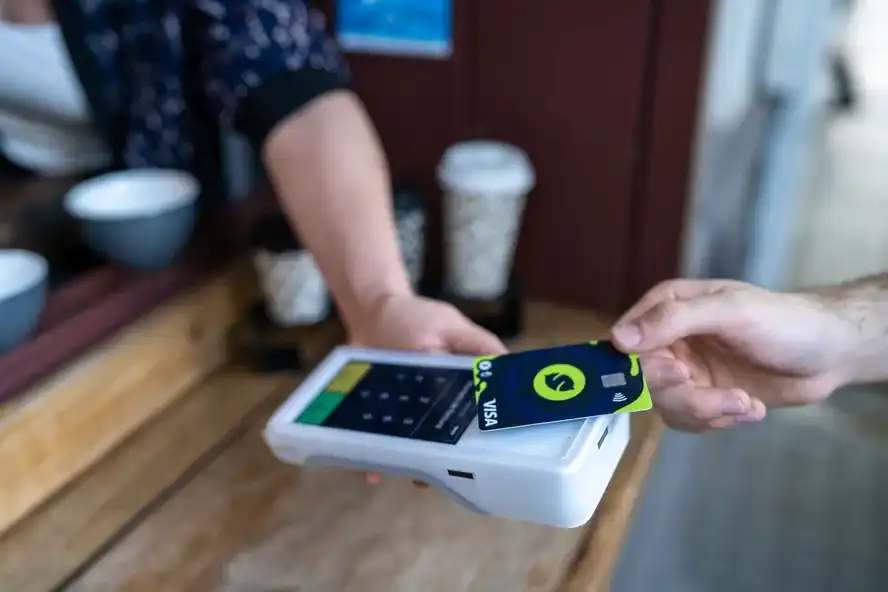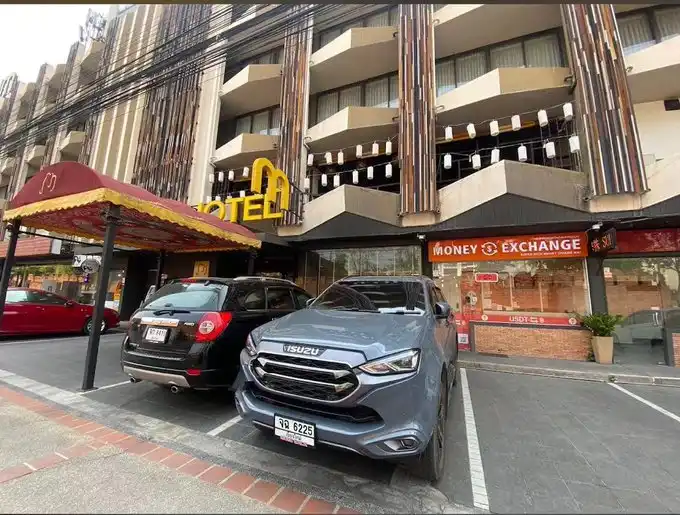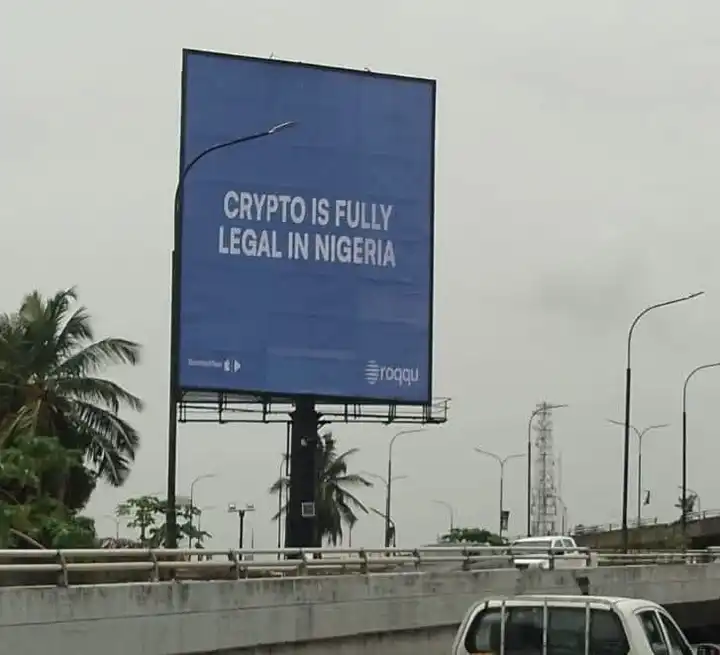“I never thought that stablecoins could be spent directly, just like using Alipay.”
Ella said with some surprise, her tone carrying a sense of astonishment as if times have suddenly caught up with me.
Her husband is a well-known KOL in the Web3 circle. In order to exchange 암호화폐currencies for legal tender, he has opened no less than five overseas bank cards. They even went to Hong Kong to exchange USDT for Hong Kong dollar cash through the narrow window like fingers.
Early in the morning on the first day of their trip to Vietnam, they walked into a chain coffee shop in Ho Chi Minh City. After ordering lattes and baguettes, the clerk pointed to a QR code on the cash register screen and said that they could use USDC. Ella took her husbands phone and tried to scan the code with her wallet. The payment interface popped up and the payment was completed in less than five seconds.
At that moment, for the first time, she didn’t just listen to people talking about how great stablecoins are, but felt it with her own fingers, and realized that it had really become a part of her daily life.
Before 2025, no one thought that the next large-scale development of the Crypto industry would be due to stablecoins.
Looking back at the previous two times, Bitcoin talked about decentralized value consensus, and NFT talked about the new generation of digital cultural symbols and identities. But they are more like symbols belonging to a specific circle, and after passing through hot searches and Moments, they returned to the wallets of a few people.
But stablecoins are different this time.
For us, stablecoins may still be a concept, policy news, or stock price K-line; but for people on the other side of the world, stablecoins have long been an indispensable part of their lives.
Stablecoins are about life and reality. They are about people working in a foreign country being able to remit their wages back home smoothly, digital nomads using USDT on their phones to pay bills in pubs, and young people without bank accounts being able to access and participate in the world.
Latin America|Young people fleeing the peso
Buenos Aires afternoons are always hot. In a convenience store on the street, Federico leaned against the counter with his phone in hand and exchanged his newly received salary from pesos to USDT. He operated a few times on the Lemon Cash interface, and a few seconds later, the screen displayed: Saldo: 873 USDT.
Federico is 26 years old and is a UI designer for a local game company. This is his entire salary for this month. Instead of going to the bank or the ATM, he immediately converted the pesos into dollars through stablecoins and saved them as usual.
Federico said that when he was a child, his family used glass jars to store US dollars, which was his earliest impression of saving money. Later, the bottles were replaced by shoe boxes under the bed and the mezzanine on the kitchen ceiling. His father even hid a few US dollar bills in the back cover of the range hood. At that time, US dollars were relatively easy to exchange. Now, to get US dollar cash, you not only have to queue up, but also risk being robbed.
Almost none of my friends keep pesos anymore. Who knows if they will still be valuable tomorrow? He shrugged, as if he had already gotten used to it.
In 2023, Argentinas annual inflation rate reached 211%, and the peso depreciated by 74% against the US dollar. Over the past few years, inflation has made the price of living here a number that is constantly refreshed and has no ceiling.
Sun is the founder of the-mu, and they build local entrepreneurial communities around the world. They came to Argentina in 2024, established a Web3 entrepreneurial community here, and organized many offline events.

The-mus offline event in Argentina. Source: Sun
Sun told a very interesting story. He and his team visited Argentina at the end of 2023. The price of a lunch in Buenos Aires was about 50 RMB. When they held an event in March 2024, the price of a lunch rose to 100 RMB. By the end of 2024, the price of this meal continued to rise to 130 RMB. Here, currency has long lost its function as a unit of measurement.
Meanwhile, the official exchange rate is still hanging on the wall to deceive people, while the black market exchange rate is not only vastly different from the official rate, but also eye-opening.
“Did you know that we have seven or eight exchange rates here?” Federico smiled helplessly. “Even when Coldplay comes to hold a concert, they can come up with a temporary exchange rate.”
He was talking about 2022. The Argentine government did introduce a special exchange rate policy for international concerts. The exchange rate was much higher than the normal exchange rate to cope with the sharp depreciation of the peso at the time and to ensure that the performers received enough US dollar income. This is a country that regards absurdity as daily life.
In such an untrustworthy system, stablecoins such as USDT and USDC began to emerge from the water like floating ice. At first, they exchanged them secretly. The US dollars on the black market were not safe, and they were afraid of being stolen or destroyed if they were placed under the bed. Later, people found that the wallet address on the mobile phone might be a safer way to save money.
In 2024, Latin America became one of the fastest-growing regions in the global crypto ecosystem, receiving a total of more than $415 billion in cryptocurrencies, with the global share rising from 7.3% to 9.1%, an annual growth rate of 42%. Among Latin American users who opened crypto apps, 40% were from Argentina. In that year, the total amount of crypto asset transactions in Argentina reached $91.1 billion, and nearly 10% of Argentines used stablecoins every month, with the highest level of activity approaching 25%.
Local stablecoin platforms such as Lemon Cash and Belo have sprung up like mushrooms after a rain, absorbing the countrys disappointment with fiat currency.
Our fiat currency is an extremely garbage memecoin. Sun said this is the consensus of all local Web3 entrepreneurs in Argentina.
Argentines have been accustomed to resisting the government and the financial system since childhood. For many young people, the first important decision they make after adulthood is not which university to attend or what career to choose, but how to prevent the little money in their hands from shrinking further. They no longer wait for a better peso policy, but choose not to wait.
These young people gradually established a new order. They still keep some pesos to pay for small daily expenses, while more expensive things, such as mobile phones, computers, and rent, are directly settled in US dollars and stablecoins. Life experience is forcing people to constantly find the most feasible solution.
“If you walk around the streets of Buenos Aires, out of 10 stores, maybe two or three will accept stablecoins,” Sun said. “You can also use Lemon Cash’s U card, which allows you to spend stablecoins in almost all merchants.”
Lemon Cash is now the largest centralized trading platform in Argentina, with 5 million monthly active users at its peak, and it can still maintain a level of one or two million at a low point. In 2024, the platform will process a total transaction volume of more than US$5.9 billion throughout the year, and exceeded US$2 billion in the fourth quarter alone. The total amount of crypto deposits in the platform has almost doubled, of which 78% are stablecoins. Behind this batch of funds are millions of people who have chosen to abandon banks and use stablecoins as digital piggy banks.

A user uses Lemon Cashs physical U card. Image source: Lemon Cash
You can see an old man carefully learning how to exchange on the Lemon Cash interface; a taxi driver asked his colleagues in the group how to withdraw USDT into cash; a high school teacher told her students, Depositing USDT is safer than storing paper money in a drawer.
They use stablecoins for savings, transfers, and inflation hedging; Lemon Cash has also embedded stablecoin financial management into the platform, and some people will start to try the financial management function within the platform to get some annualized returns. Federico said he didnt have the courage to do so. Too many high-interest scams in the past made him stay away from any investment.
Sun mentioned that a considerable number of developers who once promoted the rise of DeFi protocols were actually from Argentina, such as the security team of OpenZeppelin, researchers of Lambda Class, and the Head of Smart Contracts of MakerDAO.
Today, their compatriots are using stablecoins to bring that financial ideal into real life.
Its not that we dont want to trust the country, its just that we have trusted it before and the price was too high. Federico repeatedly said this in the interview.
And that kind of distrust also completely collapsed after the Mile memecoin incident. The new president, who was originally seen as a symbol of hope in Argentina, was coaxed and deceived into a crypto farce. Although he quickly fired the people involved, the social sentiment could not go back. The little blockchain favorability in the hearts of the proud Pampas people has once again returned to the freezing point. Web3 entrepreneurs were forced to go back to the underground, and many people began to avoid publicly announcing that they were Argentine, just to protect themselves and their families.
But even so, stablecoins have slowly penetrated. In Argentina, starting with young consumers, merchants have gradually begun to accept stablecoin payments. Although it is not yet a mainstream payment method here, once people know how to use it, it will become the most natural choice.
The peso is still legal tender, but it has been gradually neglected in peoples lives. It is no longer a measure of value, but more like an obstacle that must be bypassed.
In this country where the government frequently defaults and the economy continues to decline, people have begun to use USDT to continue saving and use stablecoins to build a daily life that will not be dragged down. Their financial life no longer depends on the country or even on banks. Their trust has shifted from the state machine to the addresses on the chain.
People no longer wait for the system to bring salvation, but find ways to survive on their own. In an era when national currencies are failing, Crypto has become another form of trust.
Southeast Asia | Young people connecting to the world through cryptocurrency
At six in the morning, Ho Chi Minh City was still shrouded in a thin layer of fog. The street cafe had just opened, and the clerk skillfully placed a QR code sign with USDC Accepted on the cash register, and wiped the moisture off the touch screen with his sleeve.
Alex ordered an Americano, stood at the counter, opened his Bitget wallet, scanned the code, confirmed, and beep, all in one go. He didnt bring a physical wallet, nor did he ask about the exchange rate. Using USDC to pay was as natural as brushing his teeth and washing his face every day.
He is from Ukraine and has been living in Southeast Asia with his wife for the past year. From Chiang Mai to Bali, to Kuala Lumpur and Ho Chi Minh City, they are always on the road. They belong to a group without borders, digital nomads. They do not need a fixed address, but they must have a financial system that can cross borders and is unrestricted. For Alex, that is USDC.
I dont go to the bank. He said calmly, as if stating a self-evident common sense. Salary, daily consumption, savings, all solved on the chain, not affected by the local banking system, and no need to worry about account freezes. My wallet is my real bank.
This is not an isolated case.
Southeast Asia has a rare financial structural dislocation: bank cards have not penetrated the population, but QR code payments are ubiquitous.
In Indonesia, almost half of adults do not have savings accounts; in the Philippines, 44% of salaried workers still carry their wages home in paper bags; and in Vietnam, the credit card ownership rate is only 4%, and card payments are still a rarity for most people. But at the same time, QR codes on mobile phones have long become the main payment method. From street vendors to massage shops and milk tea shops, almost everyone is used to scanning codes.
In just a few years, Indonesias nationwide QRIS payment network has covered more than 32 million merchants, with more than 50 million users and an annual transaction growth rate of 226%. Lowy Institute described this wave as from night market kebab stalls to tuk-tuk taillights, payments are completed in silence.

Using stablecoins for offline payments in Vietnam. Image source: Bitget Wallet
This reality of cards are difficult to popularize but QR code scanning is extremely popular provides a natural entry point for stablecoins.
Bitget Wallet is one of the earliest to try this path. They teamed up with local licensed fiat currency acceptors to build a complete backend clearing mechanism: users scan the code to pay on the front end, and the backend completes the exchange and settlement of stablecoins to local fiat currencies in real time. Karry, CEO of Bitget Wallet, said, We have been online for less than half a month, and we have already run thousands of transactions every day.
Many of the users of these stablecoins do not even speculate in cryptocurrencies.
Kari in Bangkok is a video editor whose clients are mostly from Europe and the United States. She used to receive payments through Wise or SWIFT until her account was frozen for three days due to risk control. Since then, she has switched to using USDC. I don’t understand blockchain, but I know that stablecoins are easy to use and don’t require arguing with the platform. ”
Q is another digital nomad who has lived in Chiang Mai for many years. She used the U card launched by Infini to do everything: eating, calling a taxi, booking a hotel, and even buying groceries. It was not until Infini stopped providing services that she realized that she had long bet her life on this online to offline payment system.
Im still looking for a replacement card, she said.
She visited several local currency exchange points in Chiang Mai and saw the USDT/USDC 교환 sign on the counter, and also saw WeChat and Alipay appear in the payment method column. But the exchange rate was not friendly, USDT to Thai baht was only 32.6. But she was still willing to exchange, The procedure is much simpler than the bank.

The local stablecoin exchange point in Chiang Mai; Source: Q
She added with a smile: My friend and I split the bill for dinner and used USDC to transfer money. Is this also considered a stablecoin payment?
These details are like a collage of a shadow financial system. It does not rely on banks, does not require credit history, and bypasses regulatory narratives and 디파이nitions. The people who use it are freelancers, workers, tourists, and vendors, who rely on a series of on-chain addresses to build their own financial lives.
This kind of invisible infrastructure may be what Mass Adoption really looks like.
Regulators have also noticed the direction of the tide. In 2023, the Monetary Authority of Singapore issued a stablecoin compliance framework, which explicitly requires 1:1 reserves, redemption mechanisms and transparent audits. At some strange moment, private demand and official policy began to converge tacitly.
Looking at the whole of Southeast Asia, the popularity of stablecoins has never been waiting. It has already quietly integrated into the streets and alleys: a salary remittance, a AA transfer for a meal, a cash exchange transaction. For young digital nomads, it is the underlying asset system for free migration; for local freelancers and blue-collar workers, it is a better solution for remittance, savings, and payment.
These people may not know what blockchain is, nor do they necessarily care about regulatory trends. But stablecoins have long been part of their daily lives, seeping through the cracks of life like water.
Africa | Young people abandoned by the banking system
“We went to watch the great animal migration this time and paid directly with stablecoins.”
Joy on the other side of the screen recalled the journey she had just finished a few days ago.
She is a Chinese entrepreneur doing business in Africa. She said that doing business here, the US dollar is too slow to arrive, and using RMB also requires a relatively cumbersome exchange process.
Joy spent five minutes teaching travel agencies how to use their wallets to receive stablecoins. Once USDT was sent out, it arrived in a few seconds. Then she immediately started providing them with various services during the trip.
“A lot of people already know about this,” she said with a laugh, “but they just don’t know where to start.”
In Africa, such firsts happen every day. According to Chainalysis, in the past year alone, 43% of on-chain transactions in sub-Saharan Africa came from stablecoins. Some options that were originally excluded from the system have
This continent is vast and young. According to the United Nations data in 2025, the median age of the African population is 19.3 years old, and 60% of them are under 25 years old. However, it is always depicted as thin and vague on the map of the financial system. Of the 54 countries, 33 are classified as least developed countries by the United Nations. For many people here, bank account is not the starting point of finance, but a door that can never be entered.
You need to have identification, a fixed address, a stable income, and a credit history, which are out of reach for most people.
So they changed direction and built their own financial system along the gaps.
Stablecoins are not high-concept cryptocurrencies, but rather a blunt but reliable tool. They provide young people on this continent with the ability to receive, store and spend money. Nigeria is a microcosm. In the past year, the cryptocurrency transaction volume reached $59 billion, of which 85% were small remittances of less than one million, each of which was a fragment of daily life.

Billboards in Nigeria, source: Martin
Joy is the founder of Gimlet, a stablecoin payment platform. They built an on-chain settlement system for local merchants. B-side customers pay with USDT. After the merchant confirms the order, they can receive the payment within a few seconds, which is much faster than before.
When she spoke, her tone was calm, as if she was talking about a very normal indicator improvement. But you could feel the sense of relief behind it, that the previously difficult capital flow suddenly became controllable.
“When you travel around Africa and drink coffee, you sometimes see small shops that accept cryptocurrency payments,” she said. “Of course, it’s not yet very popular, but it’s much more common than it was a year ago.”
At present, most of the merchants who accept stablecoins are large and medium-sized merchants, or hotels, travel agencies, and wholesalers that frequently deal with cross-border customers. Not everyone is using it, but you can see that this system is penetrating into the margins of daily life. It is no longer novel, but it is not ubiquitous enough.
Joy recalled that when her company was recruiting people locally, many highly educated young people would take the initiative to ask: Can we pay salaries directly in USDT?
On the one hand, it is to fight inflation, and on the other hand, it is also for tax avoidance. In the growth path of these people, banks and modern finance have never really stood on their side. In fact, it is not surprising. 70% of African countries are facing foreign exchange shortages. Sometimes even companies have to wait for several weeks to exchange some US dollars to buy machines. Being able to directly receive stablecoins has become a more secure path. According to Michael, the founder of Interlace, banks in some developing countries usually grant companies a certain amount of US dollar quotas every month. When the quota is insufficient, many companies will choose to exchange local currencies for USDT through over-the-counter methods.
Tether CEO Paolo Ardoino said at the 2025 Bitcoin Conference: They have been abandoned by the traditional financial system. This is not an exaggeration at all.
Western Union often charges 10% – 15% and the payment may take several days to arrive. Bank wire transfers may seem professional, but they often require auxiliary verification, local intermediaries and clearing agencies, and the arrival time is uncontrollable and easily interrupted.
The banking system there is quite exclusive. Martins tone was helpless when talking about his colleagues experience. The account was frozen without warning. If you want to unfreeze it, you have to pay a protection fee. This situation has been going on for several years.
Martin is the representative of Noones in China. This cryptocurrency trading platform, which supports multiple payment methods such as gift cards and bank transfers, has rapidly accumulated a large number of users in Nigeria and Ghana in recent years.

Noones at an exhibition in Africa, source: Martin
In contrast, on-chain stablecoin transfers are fast, cheap, visible, and verifiable. According to data, the cost of remitting $200 from sub-Saharan Africa via stablecoins is about 60% lower. That crypto wallet is the first account that truly belongs to many people in their lives.
However, only a relatively small number of young people will speculate in cryptocurrencies, and most people are not in a hurry to use stablecoins to participate in on-chain adventures. Joy said that most people just leave USDT there after getting it. They don’t participate in DeFi, don’t do financial management, and don’t bother.
“They only recognize TRON and basically use USDT.” Martin smiled when talking about the habits of platform users. “They have never heard of Solana or TON. They only know Bitcoin among the mainstream currencies, and even Ethereum is not popular among them.”
They have experienced how inflation turns banknotes into waste paper within three months, and stocks, bonds and gold are out of reach. For them, stablecoins are already top students if they can maintain their value and not shrink.
They all make small transfers, the most is only a few hundred U. Thousands of U are already a large number, which is almost a familys living expenses for a month, said Martin.

Noones offline presentation in Nairobi, the capital of Kenya. Source: Noones Africa
The volume of stablecoin transactions across the African continent has exceeded $30 billion, and the adoption rate in Sub-Saharan Africa has reached 9.3%. This is a future that is happening, not just a fantasy in the crypto community.
At the cross-border trade level, stablecoins have become the default tool for more and more Chinese companies to do business in Africa. The payment efficiency is high, avoiding the problem of currency exchange, and eliminating the uncertainty of intermediaries. The 2025 China-Africa Economic and Trade Expo signed 176 cooperation projects with a total amount of more than 11.3 billion US dollars. This systematic flow of funds is essentially building a use case for stablecoins. Joy believes that once the Hong Kong dollar stablecoins are implemented, they will quickly open up the situation in Africa.
Cryptocurrency is rewriting the map of African finance. Nigeria has ranked second in the global adoption index, and Ethiopia, Kenya, and South Africa are also in the top 30. The popularity of stablecoins in Africa has gradually shown signs. Joy said: When the 2027 election comes and inflation pushes it up, stablecoins will become part of the daily lives of more people.
In Africa, money has not left them, but banks have disappeared from their lives. There are no counters, no vouchers, and no credit history. People here have never belonged to the coordinate system of traditional finance, but this time, the coordinates have fallen on them. Not everyone here understands cryptocurrency, but more and more people use stablecoins to collect wages, save living expenses, and bypass banks.
Epilogue | The appearance of money is slowly changing on the other side of the world
In our daily lives, money is a line of numbers on the bank app, the scanning sound at the checkout counter, and the text message received when the salary is deposited.
But in the wider world, money is often absent. It is the closed Western Union, the only bank branch within dozens of kilometers, the fans that cannot be waved in the long queues, and the sunburned skin.
USDT, USDC and other stablecoins are not just codes and consensus, they are more like canoes that carry people across the river in the currency storm.
One day, you may come across cash receipts like this one around the world:
3.7 USDC Received flashed across the QR code light box on the street corner in Vietnam;
0.85 USDT Confirmed is reflected in the silhouette of a Kenyan coffee cup;
Rent Paid 350 USDT is written on the memo of a shared apartment in Argentina.
These numbers are quietly rewriting the meaning of the word money. They changed the face of currency from presidential portraits to hexadecimals, and moved trust from paper money ink to blockchain.
Stablecoins have quietly picked up those who have been left behind by traditional finance. Countless people use their fingertips to make tiny payments, piecing together the future financial system day after day.
On the other side of the world, the appearance of money is quietly changing.
This article is sourced from the internet: Stablecoin, a cashless payment reform for 5 billion people
introduction As a bridge connecting the traditional fiat currency and the digital currency world, stablecoins are becoming a core battlefield for capital markets and financial technology companies due to their stable prices, efficient and low-cost cross-border payments, and deep support for innovative scenarios such as DeFi. Against the backdrop of the rapid development of the global digital economy, the stablecoin ecosystem has experienced explosive growth. Whether it is the influx of capital or the gradual improvement of policy supervision, stablecoins play a key role in the future global payment system, cross-border settlement, and asset management. This article will deeply analyze the ecological layout of Circle and USDC, the compliance logic behind it, capital arbitrage opportunities, and global regulatory trends, and comprehensively show how stablecoins have set off a frenzy of…







